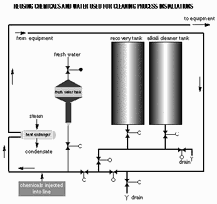Re-using chemicals and water used for cleaning process instalations
May 2000
Analytical Instrumentation & Environmental Monitoring

AFH Devers
In many cases, line injection is a good alternative to conventional generation and recovery tanks for certain clean-in-place (CIP) phases. CIP is built round the concept of recovering and reusing the chemicals and water that flush out pipes, tanks, valves and machinery. However, for certain phases of the CIP process, recovery is impractical.
The alternative is injecting the chemicals used in these phases directly into the pipeline that carries the cleaning or rinsing water. This line injection is a good way to save money on generation and recovery tanks.
In a dairy application, involving all types of dairy products, the plant line-injects acid sanitizer, at the next-to-last CIP stage (before the final rinse). So little acid is used in this phase, and the cycle weakens it so much, that recovering it would not be cost effective. There are exceptions, such as when a CIP system has to clean out a large valve manifold or a particularly long pipeline.
The acid rinse neutralises any traces of the alkaline wash that precedes it, and passivates any metal surfaces. Acid washes, on the other hand, use higher concentrates to flood the system. Recovery of wash phases is practical on a number of levels – water and chemical economy, and wastewater regulations.
One of the biggest problems with line injection is keeping the proper ratio of chemicals to water. Temperature, pressure and other changing parameters alter the amount of water in the system. Having the correct ratio of chemicals to water is especially important for plants that deal in fat-heavy products such as dairy products, as the acid washes and rinses must be washed out with alkaline.
Conductivity sensors are often used to measure the strength of the CIP solution, but they have limitations. They can be covered with mineral scale, they obstruct the pipeline, and they have trouble reading acid concentrations because acid is not as electrically conductive as alkaline. Some of the latest conductivity sensors such as the Foxboro 871FT take care of these problems through enhanced design.
Further reading:
Ensuring clean and safe water
Endress+Hauser South Africa
Editor's Choice Analytical Instrumentation & Environmental Monitoring
Endress+Hauser’s comprehensive range of disinfection sensors is designed to monitor and control disinfectant levels in water treatment processes.
Read more...
High-precision measurement of insulating gases
WIKA Instruments
Analytical Instrumentation & Environmental Monitoring
WIKA has launched the next generation of its GA11 gas analyser. It enables switchgear operators, manufacturers and maintenance companies to record the quality of SF6 gas and alternative insulating gases.
Read more...
Say goodbye to missed contamination with real-time colour monitoring
Analytical Instrumentation & Environmental Monitoring
Applied Analytics offers seamless and rapid colour monitoring in processes with an industry-proven analyser that quickly and accurately monitors colour in your sample stream for impurities and inconsistencies.
Read more...
Metrology laboratory is the heart of data-driven production consistency
Analytical Instrumentation & Environmental Monitoring
Pressing and welding have been at the core of Tier 1 automotive supplier, Malben Engineering for 50 years; but it is the company’s investment in its state-of-the-art metrology laboratory which has set it apart.
Read more...
Unlocking precision: The future of inline concentration measurement
Analytical Instrumentation & Environmental Monitoring
[Sponsored] In today’s resource-conscious industrial world, manufacturers are under growing pressure to optimise productivity, ensure consistent product quality and minimise waste. One of the most effective levers for achieving these goals lies in mastering concentration measurement, and Anton Paar is redefining how it is done.
Read more...
High-precision measurement of insulating gases
WIKA Instruments
Analytical Instrumentation & Environmental Monitoring
WIKA has launched the next generation of its GA11 gas analyser. It enables switchgear operators, manufacturers and maintenance companies to record the quality of SF6 gas and alternative insulating gases.
Read more...
Smart sensors for cleaner, safer food and beverage processes
Instek Control
Analytical Instrumentation & Environmental Monitoring
Instek Control specialises in advanced measurement solutions tailored for the food, beverage, pharmaceutical and mining industries. Among the company’s offerings are advanced process sensors from Anderson-Negele, as well as ALVIM biofilm monitoring technology.
Read more...
Elevating mining separation processes through precision instrumentation
Endress+Hauser South Africa
Analytical Instrumentation & Environmental Monitoring
In mining operations, the quest for efficiency and productivity is key. There is an urgent need for innovative solutions to enhance the performance of extraction processes while balancing operational costs and environmental impact.
Read more...
Alfa Laval launches next generation
Analytical Instrumentation & Environmental Monitoring
Alfa Laval has launched Clariot, a next generation, AI-based condition monitoring solution, precision-built for hygienic process equipment to deliver more accurate analysis and support.
Read more...
The next generation in metal sorting
Mecosa
Analytical Instrumentation & Environmental Monitoring
In the metal recycling industry, companies are increasingly challenged to not only improve the efficiency of their processes but also to raise the quality and purity of the sorted materials to new levels. By integrating proven spectral analysis technology into its market-leading REDWAVE XRF sorting system, REDWAVE is unlocking new opportunities for metal recycling, particularly in aluminium recovery.
Read more...


